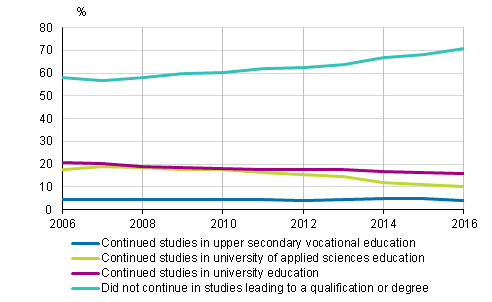Published: 13 December 2017
Only one-third of new passers of the matriculation examination immediately started further studies, nearly all completers of comprehensive school continued studies
According to Statistics Finland’s education statistics, immediate entrance into further studies for new passers of the matriculation examination was more difficult in 2016 than before, as under one third immediately continued studies leading to a qualification or degree. In ten years, the share of those left outside further studies among new passers of the matriculation examination has grown from 57 to 71 per cent. Seventy-five per cent of passers of the matriculation examination applied for further studies. Nearly all who completed comprehensive school in 2016 immediately continued to further studies, only 2.5 per cent were left outside education.
Immediate transition to further studies of new passers of the matriculation examination 2006–2016, %

In 2016, nearly 16 per cent of new passers of the matriculation examination immediately continued in university education, 10 per cent in university of applied sciences education and four per cent in vocational education. In particular, the share of women left outside further studies grew from the previous year, by four percentage points. Seventy-four per cent of new female passers of the matriculation examination remained outside education. Male passers of the matriculation examination continued more often than women in university and university of applied sciences education, 32 per cent of men and 21 per cent of women started tertiary level studies. Two per cent of men and five per cent of women started vocational education in the year of passing the matriculation examination.
The share of passers of the matriculation examination left outside further studies was highest in Uusimaa, 75 per cent, and lowest in Ostrobothnia, 58 per cent. Twenty per cent of those having passed the matriculation examination in Ostrobothnia went on to study both in university education and university of applied sciences education, most in the whole country. The share of those continuing studies in vocational education was the highest in the country, seven per cent, for new passers of the matriculation examination in the region of North Karelia. The statistics do not include data on continuation of education abroad. For example, those having completed education in ┼land often go on to study in Sweden.
Seventy-three per cent of new passers of the matriculation examination in 2016 applied to tertiary education, 75 per cent of women and 72 per cent of men. The share of those having applied only to university education grew from the previous year by four percentage points, now 41 per cent of passers of the matriculation examination applied only to university education. Eighteen per cent applied only to university of applied sciences education and 15 per cent applied simultaneously to both university of applied sciences and university education. In total, the share of new passers of the matriculation examination having applied to tertiary education was slightly lower than in the year before, when it was 75 per cent. Two per cent of new passers of the matriculation examination applied to upper secondary vocational education.
Almost all completers of the 9th grade of comprehensive school continued in education
There were around 57,600 completers of the 9th grade of comprehensive school in 2016. Nearly all completers of the 9th grade of comprehensive school applied immediately for further studies, just 0.1 per cent did not do so. Sixty-three per cent of girls applied primarily to upper secondary general school. Of boys, 57 per cent applied primarily to upper secondary vocational education.
Direct continuation to further studies for completers of comprehensive school 2006–2016

The share of completers of comprehensive school among those starting education leading to a qualification grew from the previous year, to 95 per cent. In ten years, the share has grown by four percentage points. Fifty-three per cent of completers continued in upper secondary general school and 42 per cent in upper secondary vocational education. Those left outside education moved to guidance or preparatory education or additional education of comprehensive school (10th grade). In all, 1,400 young people were left outside education.
Every tenth of those having started lower tertiary degree studies had completed a tertiary degree
Eighty-seven per cent of those having started lower tertiary degree studies in 2016 had an upper secondary level qualification as their basic education; 79 per cent the matriculation examination, two per cent an upper secondary vocational qualification and six per cent both. Twelve per cent of new students had a previously completed a tertiary level degree.
New students by education and prior qualification in 2016, %

Eighty-four per cent of those having started university of applied sciences education had an upper secondary level qualification as their basic education; 48 per cent the matriculation examination, 23 per cent an upper secondary vocational qualification and 13 per cent both.
Eighty-one per cent of those having started curriculum-based basic vocational education for young people had completed the comprehensive school, one in ten had completed the matriculation examination and the rest some other qualification. Nearly one-half of those having started studies for preparatory initial vocational education for a skills examination had completed vocational education before. More detailed information about the basic education of applicants to education leading to a qualification and new students by level of education, field of education (National Classification of Education 2016 ) and sex can be found in the database tables .
Source: Education. Statistics Finland
Inquiries: Anna Loukkola 029 551 3678, koulutustilastot@stat.fi
Director in charge: Jari Tarkoma
Publication in pdf-format (228.2 kB)
- Tables
-
Tables in databases
Pick the data you need into tables, view the data as graphs, or download the data for your use.
Appendix tables
Updated 13.12.2017
Official Statistics of Finland (OSF):
Entrance to education [e-publication].
ISSN=1799-4527. 2016. Helsinki: Statistics Finland [referred: 10.1.2026].
Access method: http://stat.fi/til/khak/2016/khak_2016_2017-12-13_tie_001_en.html

